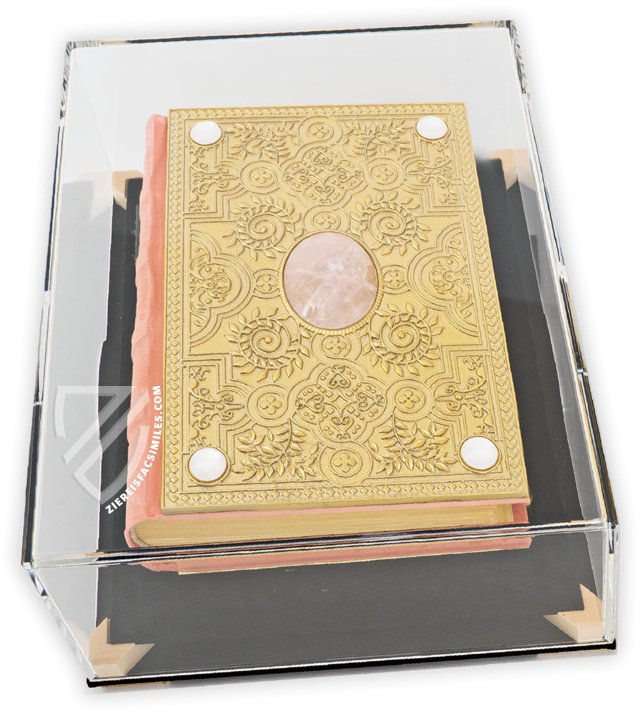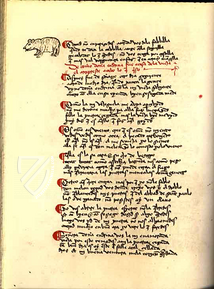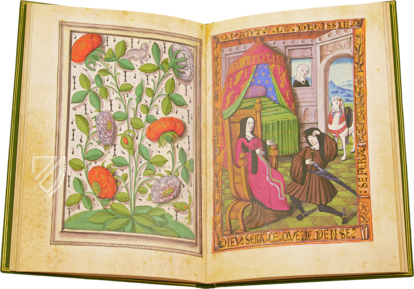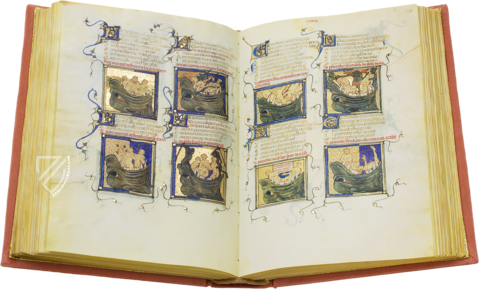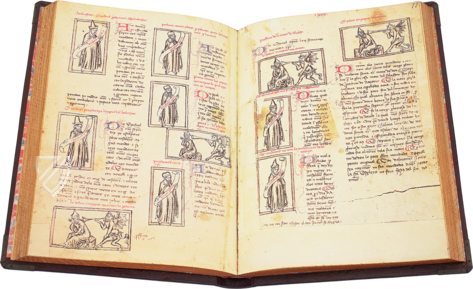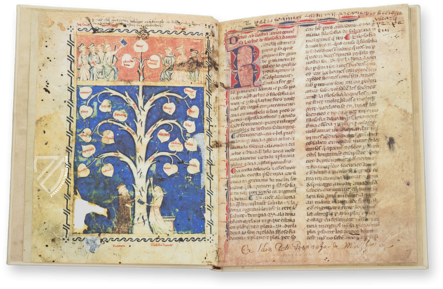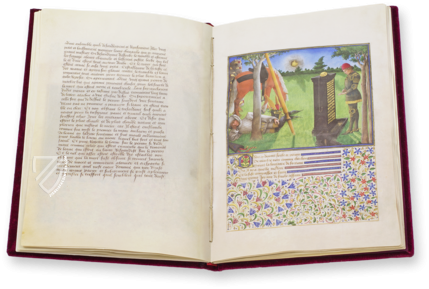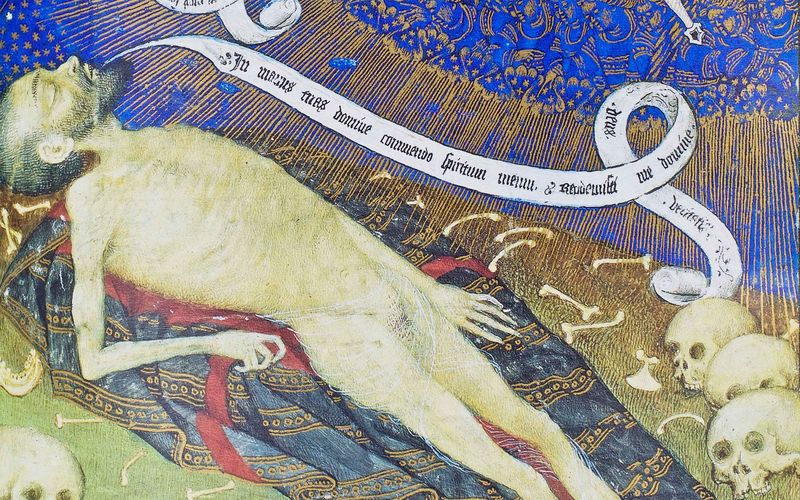The Great Book of Love
Matfre Ermengaud, about whose lives historians have little information, lived as a Franciscan monk in the 13th century. In the period of 1288–1320, the exceptionally gifted and educated monk composed a unique manuscript, which united Christian theology and historical legal doctrine with the poetry of medieval troubadours. The incomparable masterpiece by the scholar bore the title of Breviari d'Amor and is considered today to be an absolute highpoint of 12th and 13th century Occitan literature.
Breviari d'Amor de Matfre Ermengaud
A troubadour was a poet, composer, and singer of medieval courtly poetry and song. Troubadour poetry enjoyed great popularity in the 12th and 13th centuries, especially in southern France. An unusually gifted representative of this art form was the Franciscan monk Matfre Ermengaud. He composed an influential text sometime between 1288 and 1320, which cited the genre of Troubadour poetry and reinterpreted it in an unforgettable way. Today, his so-called Breviari d'Amor, which one can translate as Book of Hours of Love, is considered to be one of the most important works of Occitan poetry. It is enchantingly illustrated with 29 full-page and 192 small-format miniatures.
The Scholar Matfre Ermengaud
Today, researchers have only been able to find a small amount of information about the life of Matfre Ermengaud. He was born in the middle of the 13th century in the southern French town of Béziers. He dedicated his life to jurisprudence and poetry. He attributed particularly high worth to a comprehensive education and was a true medieval legal expert. He even obtained a law degree, which can be equated today with a master’s degree in law. When he entered into the Franciscan Order is not known. He probably already started his work on the Breviari d'Amor, before he began his life as a monk. What lends Ermengaud’s manuscript its unique status in the history of literature is the fact that his text combines the theological tradition with legal doctrines. There is no other medieval manuscript that can be compared with the work of Matfre Ermengaud.
A Literary Cultural Asset
The Breviari d'Amor contains ca. 34,500 verses and is composed in octosyllabic rhyming couplets. It is an extensive, multi-faceted, and didactic text, which can be compared with an encyclopedia. The Christian love of God was formulated in the manner of love poetry, which would have been performed by troubadours. In doing so, Ermengaud cited literary examples of the most-varied historical epochs. Quotations from classic troubadours like Aimeric de Peguilhan, Bernart de Ventadorn, and Peire Vidal are found particularly often in his manuscript. Quotations of his own from Ermengaud’s earlier writings are equally represented as well as from texts by his brother Piere. It becomes apparent thereto, just how exceptionally well read and educated the Franciscan monk was.
A Unique Work of Book Art
The work was structured in several parts. It begins with a theological section, which bears the translated title of “Studies of God and the Creation of the World”. This section addresses the Holy Trinity, angels, demons, symbols of the zodiac, and known stars and planets on each page. Thereafter follows a section with the title “Studies of Nature and the Natural Law”, in which the correct modes of divine worship were discussed, the temptations of the world were reviewed, and the sins were named that good Christians should avoid at any price. In the last section, “The Love of God”, the profession of faith is recorded along with a few legends of saints. Legendary miniatures in various sizes and in bright colors and before a shimmering gold background illustrate the comprehensive work and clarify Ermengaud’s descriptions. Additionally, the text is furnished with a gorgeous and inventive bordure adorned with flowers and tendrils.
Codicology
- Alternative Titles
- Breviari d'Amor de Matfre Ermengaud
Das Große Buch der Liebe - Size / Format
- 504 pages / 35.0 × 24.5 cm
- Origin
- Spain
- Date
- Ca. 1320
- Epochs
- Style
- Language
- Illustrations
- 29 full-page miniatures and 192 smaller miniatures
- Artist / School
- Matfre Ermengau de Beziers (author)
Breviari d'Amor de Matfre Ermengaud
Drolleries and Other Marginalia
Aside from the fine miniatures, this manuscript also features superb marginal decorations, usually in the form of brightly colored tendrils. A smiling lion is looking out at the beholder as it lounges on the left. The medallion with a patterned red background contains a drollery with the torso and face of a bald man with a white beard, but has the body of a dog. A kneeling angel with a banderole is found between this drollery and a woman reading before a patterned blue-gold background.
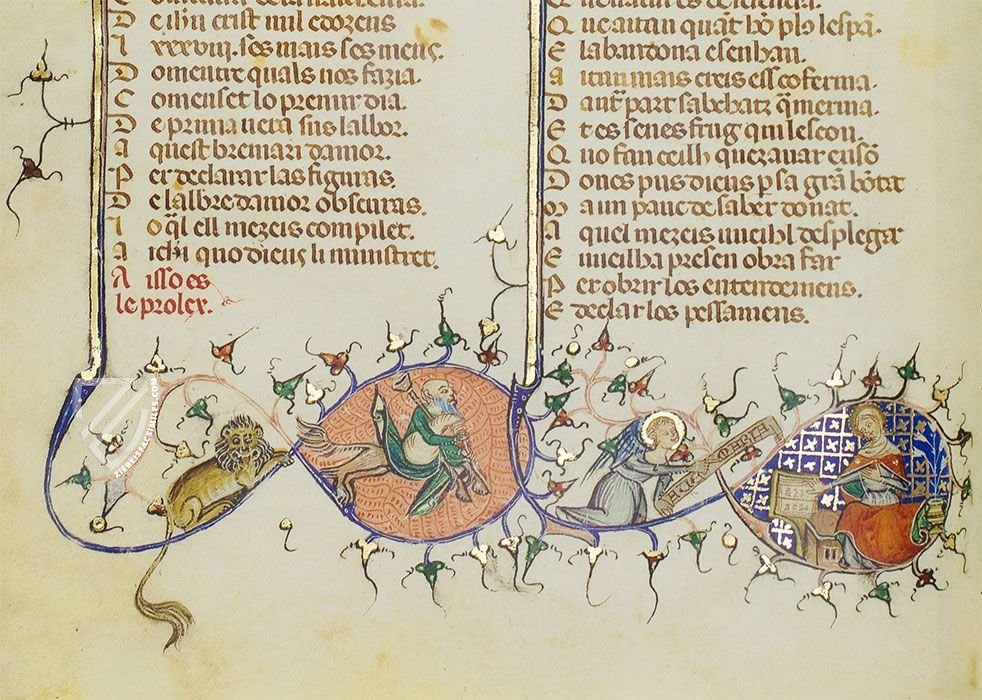
Breviari d'Amor de Matfre Ermengaud
Jaws of Hell / Temptations by the Vices / Shipwreck
One is immediately struck by the cacophony of imagery on this page, which is masterfully rendered in the finest quality materials including plenty of gold leaf. This page is from a section titled “Studies of Nature and Natural Law” and addresses inter alia the temptations of the world and sins that Christians should avoid.
At the top of the page we see the instantly-recognizable Hellmouth, one of the most famous and terrifying images of Christian art and iconography. The smaller scenes show various vices as people are tempted by hairy demons with hideous grimaces into engaging in acts of lust, greed, and violence. In the bottom right, a shipwreck is used as an allegory for a rudderless life unguided by Christian morality and law.
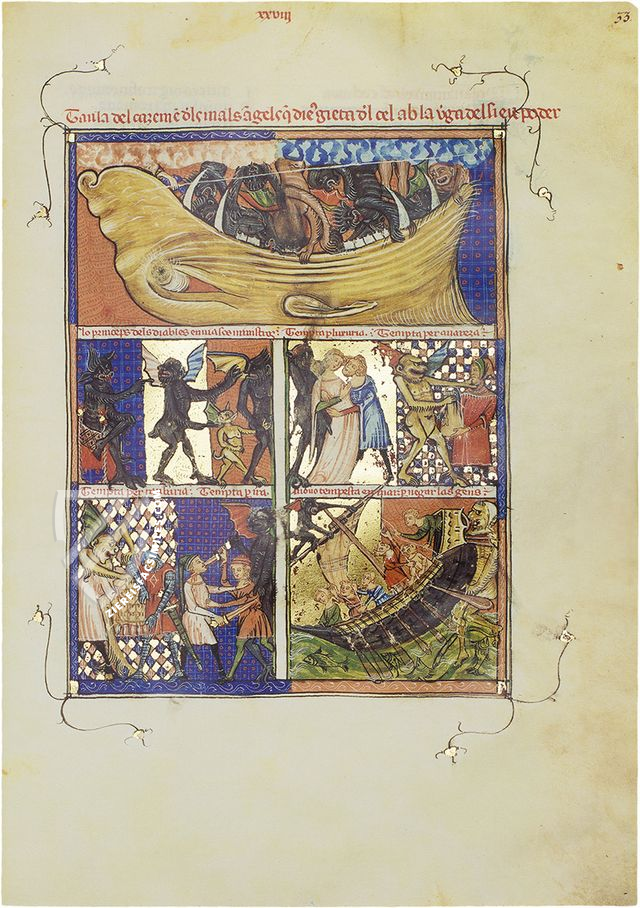
#1 Breviari d'Amor de Matfre Ermengaud
Language: Spanish
- Treatises / Secular Books
- Apocalypses / Beatus
- Astronomy / Astrology
- Bestiaries
- Bibles / Gospels
- Chronicles / History / Law
- Geography / Maps
- Saints' Lives
- Islam / Oriental
- Judaism / Hebrew
- Single Leaf Collections
- Leonardo da Vinci
- Literature / Poetry
- Liturgical Manuscripts
- Medicine / Botany / Alchemy
- Music
- Mythology / Prophecies
- Psalters
- Other Religious Books
- Games / Hunting
- Private Devotion Books
- Other Genres
- Afghanistan
- Armenia
- Austria
- Belgium
- Belize
- Bosnia and Herzegovina
- China
- Colombia
- Costa Rica
- Croatia
- Cyprus
- Czech Republic
- Denmark
- Egypt
- El Salvador
- Ethiopia
- France
- Germany
- Greece
- Guatemala
- Honduras
- Hungary
- India
- Iran
- Iraq
- Israel
- Italy
- Japan
- Jordan
- Kazakhstan
- Kyrgyzstan
- Lebanon
- Liechtenstein
- Luxembourg
- Mexico
- Morocco
- Netherlands
- Palestine
- Panama
- Peru
- Poland
- Portugal
- Romania
- Russia
- Serbia
- Spain
- Sri Lanka
- Sweden
- Switzerland
- Syria
- Tajikistan
- Turkey
- Turkmenistan
- Ukraine
- United Kingdom
- United States
- Uzbekistan
- Vatican City
- A. Oosthoek, van Holkema & Warendorf
- Aboca Museum
- Ajuntament de Valencia
- Akademie Verlag
- Akademische Druck- u. Verlagsanstalt (ADEVA)
- Aldo Ausilio Editore - Bottega d’Erasmo
- Alecto Historical Editions
- Alkuin Verlag
- Almqvist & Wiksell
- Amilcare Pizzi
- Andreas & Andreas Verlagsbuchhandlung
- Archa 90
- Archiv Verlag
- Archivi Edizioni
- Arnold Verlag
- ARS
- Ars Magna
- ArtCodex
- AyN Ediciones
- Azimuth Editions
- Badenia Verlag
- Bärenreiter-Verlag
- Belser Verlag
- Belser Verlag / WK Wertkontor
- Benziger Verlag
- Bernardinum Wydawnictwo
- BiblioGemma
- Biblioteca Apostolica Vaticana (Vaticanstadt, Vaticanstadt)
- Bibliotheca Palatina Faksimile Verlag
- Bibliotheca Rara
- Boydell & Brewer
- Bramante Edizioni
- Bredius Genootschap
- Brepols Publishers
- British Library
- C. Weckesser
- Caixa Catalunya
- Canesi
- CAPSA, Ars Scriptoria
- Caratzas Brothers, Publishers
- Carus Verlag
- Casamassima Libri
- Centrum Cartographie Verlag GmbH
- Chavane Verlag
- Christian Brandstätter Verlag
- Circulo Cientifico
- Club Bibliófilo Versol
- Club du Livre
- CM Editores
- Collegium Graphicum
- Collezione Apocrifa Da Vinci
- Comissão Nacional para as Comemorações dos Descobrimentos Portugueses
- Coron Verlag
- Corvina
- CTHS
- D. S. Brewer
- Damon
- De Agostini/UTET
- De Nederlandsche Boekhandel
- De Schutter
- Deuschle & Stemmle
- Deutscher Verlag für Kunstwissenschaft
- DIAMM
- Droz
- E. Schreiber Graphische Kunstanstalten
- Ediciones Boreal
- Ediciones Grial
- Ediclube
- Edições Inapa
- Edilan
- Editalia
- Edition Deuschle
- Edition Georg Popp
- Edition Leipzig
- Edition Libri Illustri
- Editiones Reales Sitios S. L.
- Éditions de l'Oiseau Lyre
- Editions Medicina Rara
- Editorial Casariego
- Editorial Mintzoa
- Editrice Antenore
- Editrice Velar
- Edizioni Edison
- Egeria, S.L.
- Eikon Editores
- Electa
- Emery Walker Limited
- Enciclopèdia Catalana
- Eos-Verlag
- Ephesus Publishing
- Ernst Battenberg
- Eugrammia Press
- Extraordinary Editions
- Fackelverlag
- Facsimila Art & Edition
- Facsimile Editions Ltd.
- Facsimilia Art & Edition Ebert KG
- Faksimile Verlag
- Feuermann Verlag
- Folger Shakespeare Library
- Franco Cosimo Panini Editore
- Friedrich Wittig Verlag
- Fundación Hullera Vasco-Leonesa
- G. Braziller
- Gabriele Mazzotta Editore
- Gebr. Mann Verlag
- Gesellschaft für graphische Industrie
- Getty Research Institute
- Giovanni Domenico de Rossi
- Giunti Editore
- Graffiti
- Grafica European Center of Fine Arts
- Guido Pressler
- Guillermo Blazquez
- Gustav Kiepenheuer
- H. N. Abrams
- Harrassowitz
- Harvard University Press
- Helikon
- Hendrickson Publishers
- Henning Oppermann
- Herder Verlag
- Hes & De Graaf Publishers
- Hoepli
- Holbein-Verlag
- Houghton Library
- Hugo Schmidt Verlag
- Idion Verlag
- Il Bulino, edizioni d'arte
- ILte
- Imago
- Insel Verlag
- Insel-Verlag Anton Kippenberger
- Instituto de Estudios Altoaragoneses
- Instituto Nacional de Antropología e Historia
- Introligatornia Budnik Jerzy
- Istituto dell'Enciclopedia Italiana - Treccani
- Istituto Ellenico di Studi Bizantini e Postbizantini
- Istituto Geografico De Agostini
- Istituto Poligrafico e Zecca dello Stato
- Italarte Art Establishments
- Jan Thorbecke Verlag
- Johnson Reprint Corporation
- Josef Stocker
- Josef Stocker-Schmid
- Jugoslavija
- Karl W. Hiersemann
- Kasper Straube
- Kaydeda Ediciones
- Kindler Verlag / Coron Verlag
- Kodansha International Ltd.
- Konrad Kölbl Verlag
- Kurt Wolff Verlag
- La Liberia dello Stato
- La Linea Editrice
- La Meta Editore
- Lambert Schneider
- Landeskreditbank Baden-Württemberg
- Leo S. Olschki
- Les Incunables
- Liber Artis
- Library of Congress
- Libreria Musicale Italiana
- Lichtdruck
- Lito Immagine Editore
- Lumen Artis
- Lund Humphries
- M. Moleiro Editor
- Maison des Sciences de l'homme et de la société de Poitiers
- Manuscriptum
- Martinus Nijhoff
- Maruzen-Yushodo Co. Ltd.
- MASA
- Massada Publishers
- McGraw-Hill
- Metropolitan Museum of Art
- Militos
- Millennium Liber
- Müller & Schindler
- Nahar - Stavit
- Nahar and Steimatzky
- National Library of Wales
- Neri Pozza
- Nova Charta
- Oceanum Verlag
- Odeon
- Orbis Mediaevalis
- Orbis Pictus
- Österreichische Staatsdruckerei
- Oxford University Press
- Pageant Books
- Parzellers Buchverlag
- Patrimonio Ediciones
- Pattloch Verlag
- PIAF
- Pieper Verlag
- Plon-Nourrit et cie
- Poligrafiche Bolis
- Presses Universitaires de Strasbourg
- Prestel Verlag
- Princeton University Press
- Prisma Verlag
- Priuli & Verlucca, editori
- Pro Sport Verlag
- Propyläen Verlag
- Pytheas Books
- Quaternio Verlag Luzern
- Reales Sitios
- Recht-Verlag
- Reichert Verlag
- Reichsdruckerei
- Reprint Verlag
- Riehn & Reusch
- Roberto Vattori Editore
- Rosenkilde and Bagger
- Roxburghe Club
- Salerno Editrice
- Saltellus Press
- Sandoz
- Sarajevo Svjetlost
- Schöck ArtPrint Kft.
- Schulsinger Brothers
- Scolar Press
- Scrinium
- Scripta Maneant
- Scriptorium
- Shazar
- Siloé, arte y bibliofilia
- SISMEL - Edizioni del Galluzzo
- Sociedad Mexicana de Antropología
- Société des Bibliophiles & Iconophiles de Belgique
- Soncin Publishing
- Sorli Ediciones
- Stainer and Bell
- Studer
- Styria Verlag
- Sumptibus Pragopress
- Szegedi Tudomànyegyetem
- Taberna Libraria
- Tarshish Books
- Taschen
- Tempus Libri
- Testimonio Compañía Editorial
- Thames and Hudson
- The Clear Vue Publishing Partnership Limited
- The Facsimile Codex
- The Folio Society
- The Marquess of Normanby
- The Richard III and Yorkist History Trust
- Tip.Le.Co
- TouchArt
- TREC Publishing House
- TRI Publishing Co.
- Trident Editore
- Tuliba Collection
- Typis Regiae Officinae Polygraphicae
- Union Verlag Berlin
- Universidad de Granada
- University of California Press
- University of Chicago Press
- Urs Graf
- Vallecchi
- Van Wijnen
- VCH, Acta Humaniora
- VDI Verlag
- VEB Deutscher Verlag für Musik
- Verlag Anton Pustet / Andreas Verlag
- Verlag Bibliophile Drucke Josef Stocker
- Verlag der Münchner Drucke
- Verlag für Regionalgeschichte
- Verlag Styria
- Vicent Garcia Editores
- W. Turnowski Ltd.
- W. Turnowsky
- Waanders Printers
- Wiener Mechitharisten-Congregation (Wien, Österreich)
- Wissenschaftliche Buchgesellschaft
- Wissenschaftliche Verlagsgesellschaft
- Wydawnictwo Dolnoslaskie
- Xuntanza Editorial
- Zakład Narodowy
- Zollikofer AG


